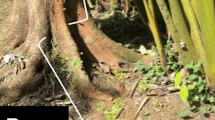Summary
Most studies on leaf-cutting ant foraging examined forest species that harvest dicot leaves. We investigated division of labor and task partitioning during foraging in the grass-cutting ant Atta vollenweideri. Workers of this species harvest grass fragments and transport them to the nest for distances up to 150 m along well-established trunk trails. We recorded the behavior of foraging ants while cutting and monitored the transport of individually-marked fragments from the cutting site until they reached the nest. A. vollenweideri foragers showed division of labor between cutting and carrying, with larger workers cutting the fragments, and smaller ones transporting them. This division was less marked when plants were located very close to the nest and no physical trail was present, i.e., the cutter often transported its own fragment back to the nest. On long foraging trails, the transport of fragments was a partitioned task, i.e., workers formed transport chains composed of 2 to 5 carriers. This sequential load transport occurred more often on long than on short trails. The first carriers in a transport chain covered only short distances before dropping their fragments, and they were observed to turn back and revisit the patch. The last carriers covered the longest distance. The probability of dropping the carried fragment on the trail was independent of both worker and fragment size, and there was no particular location on the trail for dropping, i.e., fragments were not cached. Transport time of fragments transported by a chain was longer than for those transported by single workers all the way to the nest, i.e., sequential transport did not save foraging time. Two hypotheses concerning the possible adaptive value of transport chains are discussed. The first one argues that sequential transport may lead to an increased material transport rate compared to individual transport. The second one considers sequential transport as a way to enhance the information flow among foragers, thus leading to a quicker build-up of workers at particular harvesting places. It is suggested that rather than increasing the gross transport rate of material, transport via chains may favor the transfer of information about the kind of resource being actually harvested.
Similar content being viewed by others
Author information
Authors and Affiliations
Corresponding author
Additional information
Received 19 December 2002; revised 14 March 2003; accepted 19 March 2003
Rights and permissions
About this article
Cite this article
Röschard, J., Roces, F. Cutters, carriers and transport chains: Distance-dependent foraging strategies in the grass-cutting ant Atta vollenweideri. Insect. soc. 50, 237–244 (2003). https://doi.org/10.1007/s00040-003-0663-7
Published:
Issue Date:
DOI: https://doi.org/10.1007/s00040-003-0663-7




